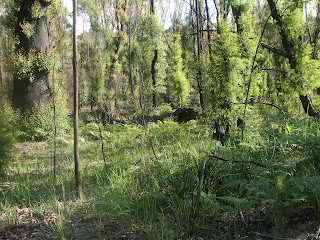October 2020
Greetings from cool, green Wat Buddha Dhamma, 10 Mile Hollow, Wisemans Ferry, NSW 2775, Australia; www.wbd.org.au
Time has passed very quickly here in the quiet bushland of New South Wales. These days it seems to go much faster with Covid restrictions on travel and visiting. Fortunately, Australia has not been as severely affected as other places, so restrictions have been easing for some time.
Just before the lock-down was initiated at the end of March, Ajahn Suddhammo returned from a stay at the new Nigrodharam Monastery, north of Melbourne, and a NZ, former-monk, with building skills, arrived to help us with our re-construction plans. Although the restrictions prevented our eager crew of Thai helpers from lending support, with the two skilled builders, work on the new Mahathera cottage was able to continue.
Even the decking is made of cement fibre board for fire resistance.
Finally, after five months of steady effort, I was able to move in to the new Mahathera cottage, although there were still occasional work days to complete some of the details, such as painting, installing curtains and tiling around the two sinks. Electricity installation is still in progress, but the wood stove works exceptionally well!
The beginning of the 'Rains Retreat' brought a winding-down of further work projects as a dedicated core group of ten people and the Sangha settled into a regular routine of eight-hours a day group practice, a weekly Sutta class, private interviews and the usual Saturday night Dhamma talk. This year Ajahn Khemavaro and I switched roles – he gave the Saturday night talks and I gave the weekly Sutta Class, discussing the Satipatthana Discourse on the development of mindfulness.
The 'Rains Retreat' for me was not as settled as in previous years when it was a time I could focus more intently upon working on my on-going book in reflective detail. The unsettledness was primarily due to some increasing health issues involving my hands. Since late last year I had been experiencing increasing numbness and then shooting pains in the fingers and wrist. Having found no lasting relief in acupuncture and massage, I enquired of a visiting doctor if it might be Carpal Tunnel Syndrome. She referred me to a specialist who quickly confirmed the diagnosis and suggested several treatments, ending with me having double wrist surgery on August 21. The operation was straightforward and only required five hours of hospital stay. The recovery, however, has been an entirely different story. Initial swelling and pain in other joints continued to increase until a further consultation revealed a flair-up of 'inflammatory arthritis'. Once this was diagnosed new medicine was immediately effective in reducing further inflammation.
Just before the ending of the Rains Retreat I received notice that my new four-year work visa had been granted. It thus appears that I will be spending more time at Wat Buddha Dhamma. In fact, later this month, a builder friend of the monastery will come to start work on a new hut for me, a bit closer to the kitchen/office complex, but higher up the hill for an expansive view over the Ten Mile Hollow valley.
The forest has sprung back to life, however, the skeletal upper branches are a constant reminder of the previous bushfire.
Although unsettled health issues and a lack of energy from struggling with pain have prevented me from giving much attention to my book on the cessation of I-making, the theme has still provided valuable food for contemplation. Two of the main sources of the continuity of I-making are ignorance and craving. I think for most people these experiences are so nebulous and vague that it is hard to get a clear sense of them. Thus, I have been reflecting on the experiential nature of ignorance and craving, and how they manifest and impinge upon our life throughout our daily existence.
Ignorance is not knowing, and can be so pervasive that we don't know that we don't know! A more insidious aspect of ignorance is incomplete knowing, especially if we are not humble enough to acknowledge the limitations of our knowing – we use our assumption of knowing to hide our true ignorance.
The word for craving, tanha, literally means 'thirst', emphasizing that it is close to a primary drive of life, which craving for existence essentially is. We may more easily recognize our erupting greed or desires while failing to observe the fundamental thirst nurturing these seemingly fleeting emotions.
Both of these factors are so all-pervasive in our life that most of us are totally unaware of how the dominate every waking moment. Fortunately, now that the Buddha has pointed them out to us, we can try to increase awareness of these insidious overlays to our life. And even though it may seem counter-intuitive to try to be aware of not-knowing, we can at least notice it's effects at times when we jump to hasty conclusions, misjudge situations or assume we know what is happening when we obviously do not – all expressions of ignorance. As we increase our awareness of craving we may notice how often we are being pushed around by liking and disliking, rather than reflectively making a conscious choice.
Seeing these effects of ignorance and craving active in our life is the dawning of wisdom and the beginning of the freedom to no longer be led along by our old habits fueled by ignorance and craving. What a change in perspective – freed of our enslavement to old compulsions!
Wishing everyone the freedom of Dhamma, good health and well-being.
Tea tree in blossom.









